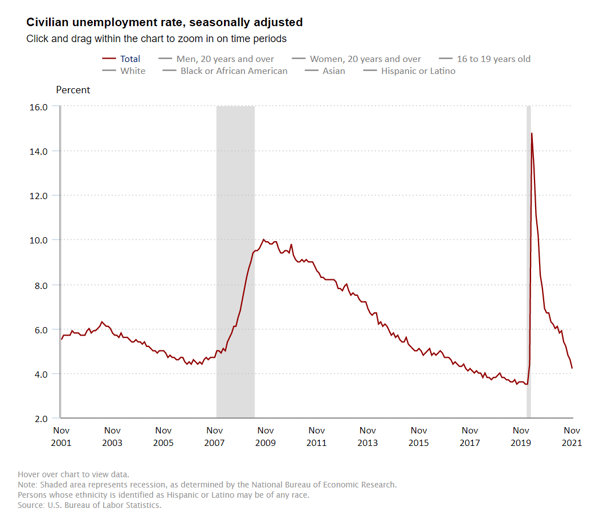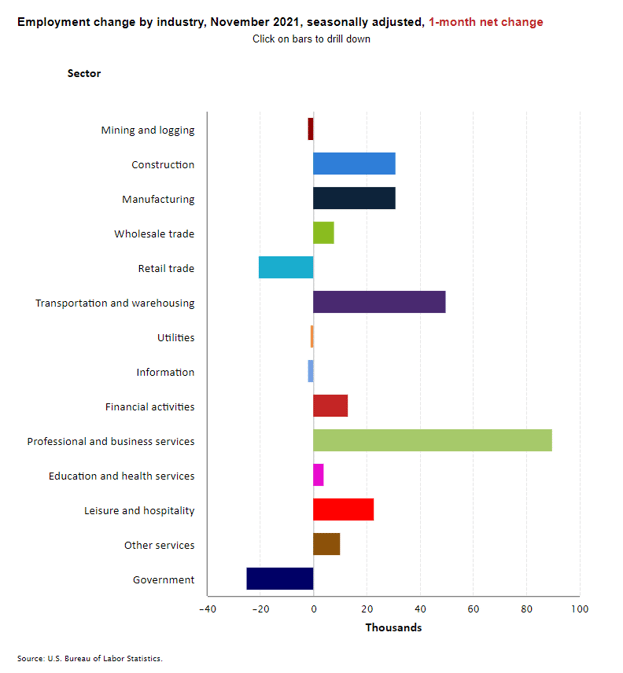The Labor Department reported that nonfarm payrolls rose by 210,000 in November 2021. The consensus had been for an increase of 550,000. This was a sharp slowdown from October when jobs increased by 546,000 (originally reported as 531,000) and from September when jobs grew by an upwardly revised 379,000 (originally reported as 312,000).
Through November, the year-to-date monthly average job gain has been 555,000. Nonfarm payrolls have now increased by 18.5 million since their pandemic trough in April 2020 but are still down by 3.9 million or 2.6% from their pre-pandemic level in February 2020.The potential negative impact of the newly identified Omicron variant on jobs is not reflected in the November data. It's far too early to tell. The data show that the labor market continues to be affected by the Delta variant especially in the hospitality sector. Indeed, leisure and hospitality payrolls edged up by a muted 23,000, following large gains earlier in the year. Employment in the leisure and hospitality industry increase by 164,000 in October and has risen by 2.54 million thus far in 2021, but it is still down by 1.3 million or 7.9% from February 2020.
Health care added 2,000 jobs in November. Nursing and residential care facilities lost 11,000 jobs. The broad health care sector is down by 450,000 since February 2020. Employment in with nursing and residential care facilities account for nearly all the loss. Jobs have been on the decline in nursing care since 2011.

Separately and from a different survey, the Labor Department reported that the supply of labor as measured by the labor force rose by a solid 594,000 in November. With the household measure of employment rising by more than 1.1 million, the jobless rate fell 0.4 percentage point to 4.2% in November. The labor force is 2.4 million below the February 2020 level. The jobless rate is now 0.7 percentage points above the pre-pandemic level of 3.5% seen in February 2020, and well below the 14.7% peak seen in April 2020.
The underemployment rate or the U-6 jobless rate was 7.8% down from 8.3% in October 2021. This figure includes those who have quit looking for a job because they are discouraged about their prospects and people working part-time but desiring a full work week.
The labor force participation rate edged up 0.2 percentage point to 61.8% in November but remains 1.5 percentage points lower than in February 2020.

Further, weekly claims for unemployment benefits fell last month below their pre-pandemic numbers for the first time since the recovery started. The four-week moving average of benefit claims dropped to 238,750 — the lowest level since the middle of March 2020, when the pandemic's effect on the labor market began to gain speed.
Nevertheless, businesses continue to struggle to find staff. The BLS JOLTS data for September showed that there were 10.4 million job openings and the highest quit rate on record.
Concerns about rising wage costs will remain after this report. Indeed, average hourly earnings for all employees on private nonfarm payrolls rose by $0.08 in October to $31.03, a gain of 4.8% from a year earlier.
About Beth Mace
Beth Burnham Mace is a special advisor to the National Investment Center for Seniors Housing & Care (NIC) focused exclusively on monitoring and reporting changes in capital markets impacting senior housing and care investments and operations. Mace served as Chief Economist and Director of Research and Analytics during her nine-year tenure on NIC’s leadership team. Before joining the NIC staff in 2014, Mace served on the NIC Board of Directors and chaired its Research Committee. She was also a director at AEW Capital Management and worked in the AEW Research Group for 17 years. Prior to joining AEW, Mace spent 10 years at Standard & Poor’s DRI/McGraw-Hill as director of its Regional Information Service. She also worked as a regional economist at Crocker Bank, and for the National Commission on Air Quality, the Brookings Institution, and Boston Edison. Mace is currently a member of the Institutional Real Estate Americas Editorial Advisory Board. In 2020, Mace was inducted into the McKnight’s Women of Distinction Hall of Honor. In 2014, she was appointed a fellow at the Homer Hoyt Institute and was awarded the title of a “Woman of Influence” in commercial real estate by Real Estate Forum Magazine and Globe Street. Mace earned an undergraduate degree from Mount Holyoke College and a master’s degree from the University of California. She also earned a Certified Business Economist™ designation from the National Association of Business Economists.
Connect with Beth Mace
Read More by Beth Mace